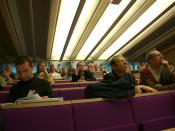Touch Football
Participation Sociology
Hypothesis
The main level of inequity, after applying Figueroa's five level framework of equity, and studying the survey information, all aspects of the framework were found to affect the participation, but the main level being the institutional level.
Introduction
Touch is fast and skilful game attracting participants of all shapes and sizes, genders and backgrounds. Touch began as a training game for the two rugby codes during the 1950's and 60's it was never seen as a sport in its own right.
Today touch enjoys a healthy level of participation both on a national front, with World Cups and Trans Tasman competitions as part of the representative calendar.
Despite the popularity of the sport throughout Australia, ILC has struggled to lure significant student numbers to their school teams. This report endeavours to identify the major sociological rates at ILC.
Sociologist Figueroa developed a framework, which allows for exploration and a greater understanding of equality issues, which exist in society and for the purpose of this report, those that are promoted in the ILC community.
These levels are cultural, structural, Institutional, interpersonal and individual.
This framework has formed the basis of this report whereby the major equity issues, which influence the participation in touch at ILC, will be identified and thoroughly discussed.
Methods of research
Research for the report was targeted at the aspect of inequity between the participation of Touch football inside of Immanuel Lutheran College (ILC). Gathered data or statistics was going to be an essential factor, so a survey was created for parent's, coaches, teachers and students that are associated with the school. The survey was limited, though because the students who did the survey consisted of only grade 11's. A range of internet sites and handouts from class were also used.
Discussion
Touch, or as it is formally known as Touch Football, comes from two Rugby codes, Rugby League and Rugby Union, and was ideally used for training. Even though the skills of Touch are close to those of these two sports, there is no body contact at all. The game is generally focused on running and agility, with hand passing and catching as main skills. Touch is played with the aim of moving the ball towards the opponents score line by running and passing the ball backwards to your teammates. The Rugby tackle has been replaced with a simple 'touch' by the defender followed by a play the ball action (a roll- ball). Because there is no rough play, getting dirty on the ground or likely injuries to occur, touch is a great mixed sport ideal for both boys and girls.
So why is there so little participation in the game touch at ILC?
To answer this question we must take a step back and have a look at Figueroa's five levels of inequity:
1. Cultural
2. Structural
3. Institutional
4. Interpersonal
5. Individual
In these five levels we will be able to identify the main contributing factors for the lack of participation inside the ILC community.
Cultural Level
"The cultural level refers to the socially shared sets of assumptions, beliefs values and behavioural norms, linked to concepts such as race and gender' (Kirk et al 1999 p.130)
The hard, tough life of the early days of white settlement fostered a hard, tough culture that's still current today. The great Australian stereotyped cultural identity is recognised as a tough battling nation, where the males are bred strong, aggressive and rough, and the females are brought up to be delicate, pretty and emotional.
This gender stereotype has certain effects on the certain sports male and females play. For males, Rugby Union, League or AFL are recognised sports, as they involve physical contact and strength, whereas girls are expected to play sports, which require less coordination and little physical contact. This is confirmed from statistics in the survey, where over half of the percentage from students, teacher, coaches, and parents encourage males to play Rugby Union, and just under half for netball for females.
Certainly, Touch being a non-contact sport showing no aspects of rough, aggressive behaviour, is seen, by the majority, as not a very suitable sport for males to play, and a game involving a football is seen as not an appropriate game for girls.
Structural
"The structural level is concerned with the factors such as resources, rewards, social position and power" (Kirk et al. 1999 p.130)
Major Rugby Union playing countries are Australia, England, France, Ireland, Italy, New Zealand, Scotland, South Africa and Wales.
The minor nations include Argentina, Canada, Fiji, Georgia, Japan, Namibia, Romania, Samoa, Spain, Tonga, United States, Uruguay.
(http://en.wikipedia.org/wiki/Rugby_football)
Because the of huge international media cover, Rugby League is a highly popular game both in the ILC institute, (See appendix Graph 1) and internationally.
Players of this highly popular game are in turn regarded to have high social position,
Whereas Touch, now played in 23 countries across the globe, including Great Britain, USA, Japan, NZ, and Canada
(http://www.aussport.com.au/sponsorship/touchsa.htm), has almost no media coverage, giving it a low social placing. Players of Major Rugby Union also get generous rewards (clubs paying them to play), whereas major touch club players get no money.
Institutional
" This level refers to the way society and institutions advantage and disadvantage particular group due to their regular and routine practices". (Kirk et al. 1999 p.131)
Within the ILC environment, the college states it strives to provide all students with equal opportunities academically, culturally and on the sporting field. From general knowledge, it is obvious that this statement is incorrect. The institute provides special resources to help promote the game Rugby Union, such as Rugby jerseys, Special floodlights enabling rugby matches to be played at night and a highly expensive trip overseas to Canada. Where as there isn't even a team open to play in for touch, giving no opportunity to play at all. In the survey people were asked "which Interschool team sport do you believe has the highest participation numbers, and the greatest support from the staff and student body at ILC?" Here was the result. (See graph 1)
Interpersonal
"This level refers to the interactions and patterns of relations between people" (Kirk et al. 1999 p.131)
Because of Australia's cultural background, peoples own opinion can influence a person's choice of activities. Because of the institute's promotion of the game Rugby Union, it has influenced students to play, which in turn can influence the individual decision. This is heavily because of peers; if your friends play you are influenced, especially if they think its cool. This can occur the other way around also, if your peers opinion is that a certain sport is uninteresting or a 'girls sport' this can also have a big influence on an individual. In the survey evidence was found that rugby was the most favoured sport in interest rankings. (See table 1)
Surveyed Interest Ranking
Students Rugby 1 - Touch 3
Teachers Rugby 1 - Touch 4
Coaches Rugby 1 - Touch 2
Parents Rugby 1 - Touch 5
(Table 1)
Individual
"This level is concerned with the attitudes and often stereotypical beliefs each of us hold as individuals" (Kirk et al. 1999 p.131)
Many families have strong stereotypical beliefs (which is usually similar to their cultural beliefs), which usually succumb to girls staying home with the mother, while the father and son go out and kick the football around. This at an interpersonal level can manipulate the individual level, giving the individual their set of beliefs and attitudes. For verification of this, reference to the survey is below.
Conclusion
From the analysis of surveyed data, a verdict to identify the major sociological factors contributing the current status of participation in the ILC community is found. And the result is a disadvantage from all levels of Figueroa's framework of equity, but mainly, in my opinion, the institutional level.
The college shows a certain fondness for Rugby Union, giving them certain privileges, such as the floodlights installed, jerseys, overseas trips etc., which in turn gives the sport a promotion and advantage over participation.
Australia, as a whole has currently 250,000 registered Touch players with approximately 500,000 school children playing the sport. This evidence confirms that Immanuel Lutheran College is not providing satisfactory equal opportunities on the sporting field, especially if 41% of people who did the survey would play Touch Football if given the chance. (See Graph 3)
Recommendations
Touch Football is a fun, exciting, inexpensive, safe, skilful and enjoyable game all-round, and should have more priority in the institute of ILC. The college should stay true to its policy "Ideally within the College environment we strive to provide all students with equal opportunities academically, culturally and on the sports field" and change the inequity by opening up a team and supplying equal resources as other sports.
Bibliography
1. http://www.cultureandrecreation.gov.au/articles/football/
2. http://www.cybersydney.com.au/kids/sar/touch.html
3. http://www.victouch.com.au/whatistouch.html
4. http://www.aussport.com.au/sponsorship/touchsa.htm
5. http://www.austouch.com.au/index.cgi?sID=16
6. http://images.google.com/imgres?imgurl=http://www.victoriatouchfootball.ca/images/vtflogo.jpg&imgrefurl=http://www.victoriatouchfootball.ca/&h=161&w=150&sz=6&tbnid=uGTycCstLR4J:&tbnh=91&tbnw=85&start=13&prev=/images%3Fq%3Dtouch%2Bfootball%26hl%3Den%26lr%3D%26ie%3DUTF-8%26safe%3Doff
7. http://en.wikipedia.org/wiki/Rugby_football
Appendix
1.
2.
3.
4.
Surveyed Interest Ranking
Students Rugby 1 - Touch 3
Teachers Rugby 1 - Touch 4
Coaches Rugby 1 - Touch 2
Parents Rugby 1 - Touch 5
(Table 1)


